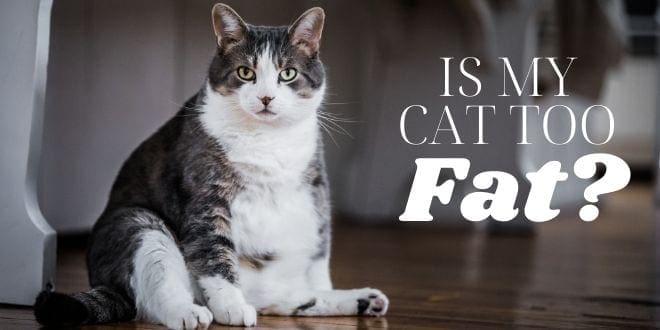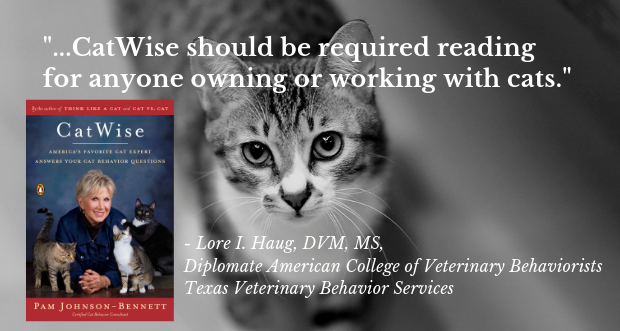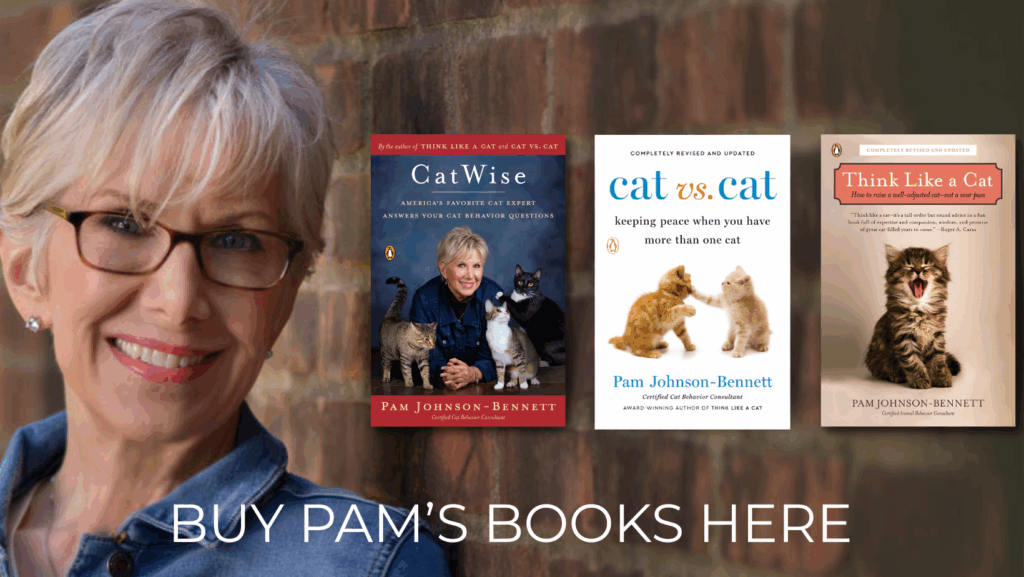
Many cat parents have simply gotten used to the image of an overweight cat and perhaps no longer recognize what their cats should look like in terms of a healthy body. Are we over-feeding out of love? Lack of knowledge? Convenience? An outdoor cat who depends on his ability to hunt in order to eat, is getting the perfect meal… a mouse, while our beloved indoor cats are getting stuffed like a Thanksgiving turkey with carbohydrates. Am I suggesting you turn your indoor cats into outdoor cats? Not at all. I’m suggesting you take a good look at what you’re feeding your cats, how you’re feeding and how much activity you provide for them.
Are You Feeding Your Cat The Wrong Food?
Cats are obligate carnivores and they must get protein from animal sources. Cats who are eating only dry food may be getting too many carbohydrates in their diet. Dry food is typically sprayed or coated with animal digest to increase its taste appeal. A cat who is eating just dry food has to eat more of it in order to get adequate amounts of protein (and with some lower quality dry food much of the protein may come from plant sources and not animal). The high carb amounts in the dry food can alter the cat’s blood sugar which then can lead to obesity. The “lighter” versions of dry food might be the worst culprits of all because they contain higher fiber and more carbs. The protein and fat in food, not the carbohydrates, are the things that send the signal to the cat’s body that it has received adequate amounts of what it needs.
The other problem with dry food is that it has a very low water content. A cat on an exclusively dry food diet may not be getting adequate amounts of water which could lead to urinary problems. Wet food (canned, raw, or homemade) has a much higher water content and the cat has a better chance of getting adequate water through diet. In an outdoor setting, a cat who hunts would benefit from the moisture content within the prey he catches, to satisfy much of the body’s moisture requirements.
Are You Feeding Your Cat Too Much Food?
Dry food may lead to obesity because it’s convenient for free-feeding. Some cat parents load up the food bowl with a heaping mound of dry food for their cats to nibble on throughout the day. Perhaps some cat parents do it because they’ve been led to believe cats self regulate their food intake. Unfortunately, that isn’t always the case or else we wouldn’t be seeing so many overweight cats. Many cat parents also rely on the convenience of how dry food can be left out all day. For busy cat parents this makes life easier so a family member doesn’t have to rush home in time to supply kitty with dinner.
Is Your Cat Bored?
Many indoor cats aren’t receiving adequate environmental enrichment so they don’t have to do much mental or physical work to earn their meals. Cats are hunters and they’re born to work for food. They’re hardwired for mental and physical activity and yet the only activity too many cats are getting is the limited number of steps they have to take in order to reach the food bowl… a bowl that’s brimming with a mountain of carbohydrate-rich dry food.
Putting Your Cat on a Weight Control Program
Before you even begin to start a weight management program for your cat, be sure he gets a thorough examination from the veterinarian. You need to know exactly what potential health concerns your cat has so you can address that as part of the nutritional program. In some cases, there could be an underlying medical issue actually causing the weight gain. Your veterinarian can also tell you how much you should be feeding your cat in order to have safe weight loss. It’s crucial that you not put your cat on a drastic diet where he loses too rapidly. A drastic reduction in calories can result in a condition known as hepatic lipidosis. This is a life-threatening condition that affects the liver. Cats who don’t eat for 48 hours or who are put on a highly restricted calorie intake are at risk. That’s why it’s very important to do a gradual weight reduction program and do it with your veterinarian’s guidance. Your cat’s case is very individual and your veterinarian can tell you how much your cat should safely lose each month in order to stay healthy. A gradual weight reduction program is also better from a behavioral standpoint because your cat won’t become frustrated and confused by a sudden drastic decrease in food quantity.
Any kind of weight reduction plan should also be partnered with an increase in activity. If your cat is extremely obese then that activity may be very limited at first but ANY type of movement is beneficial. Playtime with an interactive toy is a great way to help your cat begin an exercise program. The great thing about an interactive play session is that you can control the level of activity. For a very overweight cat you can limit the movements of the toy so it’s not too taxing on the cat. As the cat gets healthier you can increase the challenge level. Keep in mind though that for an extremely overweight cat you don’t want to put too much stress on the joints. Ease into an exercise program.
Make Sure All Family Members Cooperate When it Comes to Your Cat’s Nutrition
Nothing undermines a weight reduction plan faster than having one family member sneaking food to the cat. Before you begin the program make sure everyone in the family, including your children, understand the importance of what is being done for the cat’s health and how it’s imperative that everyone is on the same page. Some family members can feel really guilty when they see the family cat begging for food or sitting in front of the empty food bowl as if he hasn’t had a meal in a week. Nip that guilt in the bud or else the cat will be the one who ultimately suffers.
Don’t Forget the Fun Factor for Your Cat
Having been on more than my share of diets in my life, I understand that it’s not something anyone looks forward to but you can make it more fun. The fact that playtime can be a source of exercise automatically increases the fun factor right there. Your cat may need those predatory skills dusted off a bit if playtime hasn’t been a part of daily life, but you can make it a session he thoroughly enjoys. Also, incorporate puzzle feeders as a fun way to feed your cat so he doesn’t just gobble down a bowl of food in 15 seconds. Make “working” for food fun by way of a puzzle feeder. There are puzzle feeders designed for both wet and dry food. Do an online search for puzzle feeders and you’ll see the ever-increasing types of products available.
Need More Information?
If you have a question about your cat’s health, nutrition, or weight, contact your veterinarian. This article is not intended as a medical diagnosis nor is it a replacement for your cat’s regular veterinary care. This article is for general information purposes only.
For more information on cat behavior and training, refer to the books by Pam Johnson-Bennett. Pam’s books are available at bookstores and online. We’ve included links to Amazon here on our website.




